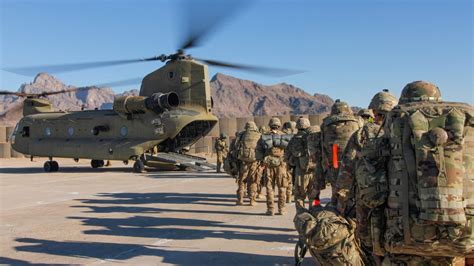Akhil Ramesh, opinion contributor
In President Biden’s address to Congress on American foreign policy, there were two instances where he earned a standing ovation – one was for his statement on the Indo-Pacific and the other was for ending the “forever war” in Afghanistan. Strikingly, the latter received a lukewarm salvo, across the political spectrum.
The departure clearly indicates the lack of a broad consensus in Washington, on Biden’s troop withdrawal from Afghanistan. The most prominent leaders to be at odds with Biden’s policy are the two former Secretaries of State – Hillary Clinton from the Obama administration and Condoleezza Rice from the Bush administration, both of whom while speaking to the House Foreign Affairs Committee expressed concern over the Biden administration’s decision to completely withdraw troops from Afghanistan, citing the revival of terrorist outfits as the major cause for concern.https://www.dianomi.com/smartads.epl?id=3533
However, that would be the tertiary cause for concern. As many analysts have predicted, with the U.S. out of Afghanistan, the security situation in the country will only deteriorate and the countries in its periphery will have the most at stake to get involved in the chaos that ensues. China would be the frontrunner to step into that quagmire.
China would send in its troops to prevent any security situation from overflowing into its South Western province of Xinjiang and to protect its investments in the flagship Belt and Road Initiative (BRI). The BRI is a connectivity and development initiative of Chinese government to increase commerce and trade along the historical silk trade route. The belt refers to the overland routes for road and rail transportation and the road refers to ports and maritime infrastructure projects.
As part of the initiative, China has agreed to inject from $280 billion to over $400 billion in Iran’s oil, gas, petrochemical and other industries over the course of 25 years in exchange for cheaper oil. Furthermore, through the signing of a strategic pact in 2020, China can now deploy up to 5,000 military and security personnel in Iran. Similarly, Pakistan has been one of the largest recipients of Chinese aid and investments that fall under the BRI label. The China-Pakistan economic corridor (CPEC) is already valued at over $62 billion and to protect those assets, both private and national security personnel work around the clock.
A cursory view of a map of the region would inform one that Afghanistan had been the missing piece in the puzzle for China’s BRI, due to its geographically and strategically significant location between Iran and Pakistan. By fixing that piece, the Belt portion of the BRI will run seamlessly, making China the hegemonic power in the region, a title both the Soviet Union and U.S. had failed to earn, even with trillions of dollars in military spending. To that end, China would not hesitate to deploy its peacekeepers, as mentioned by Sun Qi of the Shanghai Academy of Social Sciences, “If the security situation poses a significant threat, China may send peacekeeping troops to the region to ensure the safety and interests of Chinese people and companies there.”
Moreover, given Iran and Pakistan’s close relations with China, with the latter even being referred to as the “all weather friend,” China’s greater involvement in Afghanistan will leave Western countries out of the mix and more importantly, even its regional partners such as India out of the picture.
As the President of Afghanistan wrote in his recent article in Foreign Affairs, “Pakistan provides the Taliban with support for logistics, finance, and recruitment” and Pakistan could leverage America’s withdrawal to settle its historical dispute with India in Kashmir. In the recent past, Pakistan-based militant organizations, the Lashker-e-Taiba and Jaish-e-Mohammed, the Afghan Taliban and Islamic State-Khorasan, the local affiliate of the terror group, have come together to carry out raids on Indian assets in Kabul.
While Biden’s address on ending forever wars comes as a breath of fresh air in Washington, Americans have shed too much blood, sweat and tears over the last two decades to hand over the hard fought gains on a platter to either the Taliban, China, or both. In the event that China or/and the Taliban gain primacy in the region, it would be America’s vital Indo-Pacific partner and the world’s largest democracy, India, in peril. And as an extension, the U.S. Indo-Pacific strategy with India will shift its resources to its Western border with Pakistan.
In order to prevent America’s actions on curtailing China from becoming a one step forward and two steps backwards endeavor, the Biden administration, post withdrawal, should expand the scope of its engagement with Afghanistan. It should include “building back better” – not nation building, but building supply chains, trade blocs and economic partnerships. To fulfill that effort, America would not have to spend its tax dollars, all it would have to do is not be an impediment to the efforts of its Quad partners – India and Japan. Both Japan and India enjoy a favorable view of their presence in Afghanistan and the wider region and both countries have little to no history of military engagement in the region to have any misgivings. The U.S. should capitalize off this goodwill and launch a three-pronged approach to continue engagement with countries in the region.
First, the U.S. should give sanction waivers to Indo-Pacific partners to trade and invest in Iran. This will assist projects like the Chabahar port in Iran, supported by India to be completed on time. Secondly, support Quad members’ investments in rare earth mining activities in the region through development financing. And finally, increase intelligence sharing and defense cooperation with India to prevent any escalating security situation in Afghanistan from overflowing into the Kashmir valley or becoming a threat to American assets.
This model of engagement will prevent the region from becoming a protectorate of China and demonstrate to the world that America’s engagement with countries in the region can be beyond the sunk cost fallacy of forever wars.

